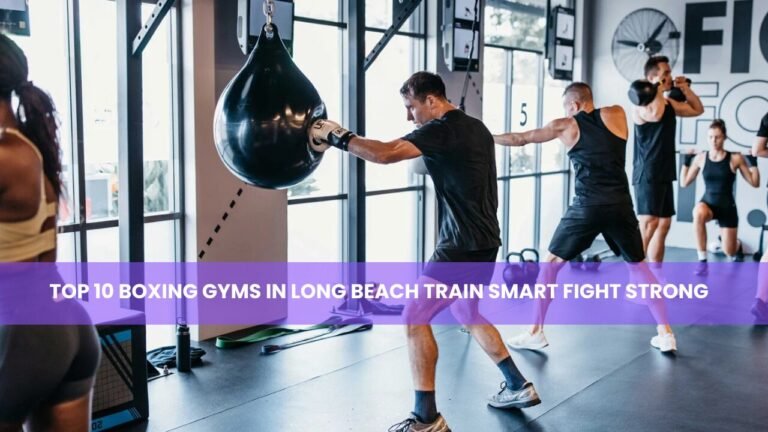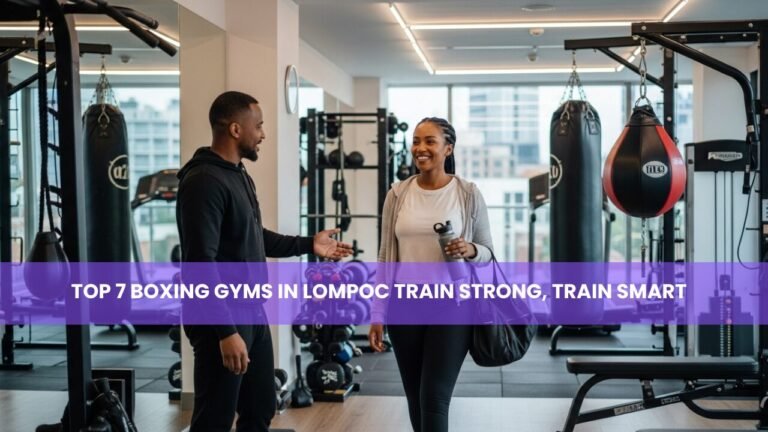If you have ever dreamed of stepping into the ring at a professional level, then choosing the right boxing gyms to become pro is one of the most important decisions you will make. Many people begin boxing as a way to stay fit, build confidence, or learn self-defense, but for those with ambitions to compete professionally, the type of gym you train in can shape your career. A fitness-oriented boxing class at a commercial gym may be fine for beginners, but serious fighters need a dedicated training environment that emphasizes technical skill, discipline, and access to the professional boxing network.
This article explores what makes a boxing gym truly professional, highlights world-famous facilities, and provides guidance on how aspiring fighters can progress from beginners to professional boxers.
Why the Right Gym Matters in Professional Boxing
The gym where you train will influence not just your technique, but also your mindset, connections, and opportunities. A good boxing gym does more than teach punches and footwork. It creates a system that prepares fighters physically and mentally for the challenges of professional bouts. In a professional gym, the coaching is usually more advanced, focusing on precision, endurance, and ring strategy. Fighters also gain access to sparring partners who push them beyond their comfort zone, forcing them to adapt and grow.
In addition, a professional boxing gym often has established ties with promoters, managers, and event organizers. These connections are essential for anyone aiming to move from amateur competitions to paid professional fights. A supportive culture also plays a huge role. Training for professional boxing is grueling, and being surrounded by others with the same level of ambition can help fighters stay disciplined and motivated during long, demanding training camps.
What to Look for in Boxing Gyms to Become Pro
Not all boxing gyms are designed with professional aspirations in mind. Some gyms cater primarily to hobbyists or people interested in fitness, while others have a proven record of producing champions. If you are looking for boxing gyms to become pro, there are several essential factors to consider.
The first is the quality of the coaching staff. A professional-level gym typically employs trainers with backgrounds in competitive boxing, and many have coached or even fought at the professional level themselves. This level of expertise ensures that you are not just learning the basics, but also mastering advanced techniques, ring strategy, and fight preparation.
Reputation is another major factor. Some gyms are recognized globally because they have trained world champions, Olympians, or top-ranked contenders. A gym’s history provides insight into whether it can actually take fighters to the next level. Training in a gym that has consistently produced professional fighters is often a strong sign of credibility.
Sparring and competition opportunities are also crucial. A serious gym will not only give you regular sparring sessions with highly skilled partners, but also help you transition from amateur to professional competition by connecting you with fight opportunities. Without live sparring against quality opponents, it is nearly impossible to develop the timing, resilience, and adaptability required in the ring.
Facilities matter as well. Professional boxing requires conditioning, recovery, and technical training. Gyms that invest in rings, heavy bags, double-end bags, weights, conditioning equipment, and even sports therapy show that they take fighter development seriously. Finally, consider the gym’s network. Many professional boxing gyms have close ties with promoters, managers, and scouts. Being in the right gym can mean being seen by the right people at the right time.
Famous Boxing Gyms That Built Champions
Some boxing gyms are so iconic that they are known not just for their facilities but for the champions they have produced. These gyms are proof of what the right training environment can accomplish.
Wild Card Boxing Club in Los Angeles, founded by legendary trainer Freddie Roach, is one of the most famous gyms in the world. It has been home to champions such as Manny Pacquiao, Amir Khan, and Miguel Cotto. The training environment is highly competitive, but that intensity has made it a magnet for fighters determined to prove themselves at the highest level.
Another iconic gym is Gleason’s Gym in Brooklyn, which has been operating since 1937. With a rich history that includes boxing greats like Muhammad Ali, Mike Tyson, and Roberto Durán, Gleason’s is not only a gym but a living piece of boxing history. Many professional fighters continue to train there today, drawn by its reputation and the wealth of knowledge within its walls.
In Las Vegas, the Mayweather Boxing Club stands out as a hub for elite fighters. Founded by Floyd Mayweather Jr., the gym emphasizes precision, conditioning, and discipline, and it continues to attract fighters who want to follow in Mayweather’s footsteps. Similarly, Kronk Gym in Detroit, where Thomas Hearns trained, remains one of the most respected names in boxing. Kronk has a tradition of producing tough, technically skilled fighters who go on to achieve international recognition.
Local vs. International Boxing Gyms
Aspiring fighters often face the choice between training at a local gym and traveling to internationally renowned facilities. Each option has its advantages and challenges.
Local boxing gyms provide accessibility, affordability, and a sense of community. They are often the starting point for young fighters who are just learning the fundamentals. Training close to home also allows boxers to build experience without the financial burden of relocating. Many successful professionals began in small, local gyms before moving on to larger facilities once they had proven themselves in amateur competition.
International gyms, on the other hand, offer exposure to top-tier trainers, advanced training programs, and opportunities to spar with world-class fighters. Training in these gyms can be highly competitive and expensive, but they also offer unparalleled opportunities for growth and visibility. For some boxers, making the move to a global training hub is a necessary step to secure a professional career.
Steps to Go from Amateur to Pro Boxer
Finding the right gym is just the beginning. The journey from amateur to professional boxing involves years of commitment and strategic planning. Most fighters begin by competing in amateur tournaments. These competitions build experience, develop ring confidence, and establish a reputation that can attract professional opportunities.
Once you have proven yourself in the amateur circuit, the next step is to commit to a gym that is specifically geared toward professional training. At this stage, having a coach who understands the transition from amateur to pro fighting is critical. A good coach will not only refine your technical skills but also prepare you for the business side of professional boxing, including contract negotiations and promoter relationships.
Professional boxing also requires full-time dedication. Unlike amateur competition, where fighters may train part-time, going pro demands total commitment. Nutrition, conditioning, and recovery become as important as sparring and technique. Successful professional fighters often work with nutritionists, strength and conditioning coaches, and mental performance specialists to gain every possible advantage.
Finally, having the right manager or promoter becomes essential once you are ready to step into the professional ring. Managers handle negotiations, secure fights, and guide career development. Without industry connections, even talented fighters may struggle to get the opportunities they need.
Real-World Example: Canelo Álvarez’s Training Approach
Canelo Álvarez offers an excellent example of how the training environment influences success. He trains in San Diego with long-time coach Eddy Reynoso at a facility tailored specifically to his needs. The gym itself is not flashy, but it provides everything necessary for elite performance, including technical training, strength and conditioning, and a focused atmosphere. What makes this camp effective is not just the equipment but the consistency of his routine and the deep trust between fighter and coach.
This example demonstrates that while famous gyms provide opportunities, what ultimately matters most is the quality of training and the support system surrounding the fighter. A dedicated coaching team, a culture of discipline, and a focus on professional growth can elevate a boxer to world-class status.
FAQs
What is the difference between a regular boxing gym and a pro-level gym?
A regular boxing gym typically caters to beginners and fitness enthusiasts, focusing on general boxing techniques and conditioning. A pro-level gym, however, is designed to prepare fighters for sanctioned competitions, offering advanced sparring, tactical training, and structured programs aimed at professional development.
How much does it cost to train at a professional boxing gym?
The cost varies depending on the location and reputation of the gym. Local gyms may charge between $50 and $100 per month, while elite international gyms can range anywhere from $300 to $1,000 or more. Additional expenses may include personal coaching, nutrition guidance, and travel for competition.
Can someone become a professional boxer without training in a big-name gym?
Yes, many fighters begin their careers in small local gyms and only move to larger facilities once they have built a strong amateur record. The most important factors are quality coaching, discipline, and consistent competition. While big-name gyms offer exposure, they are not the only path to success.
How long does it usually take to go pro?
The timeline varies greatly depending on the individual. Most fighters spend several years competing in amateur boxing before turning professional. The journey depends on natural talent, dedication, training consistency, and the opportunities available through coaches and promoters.
Do I need a manager or promoter at the start of my career?
In the early stages, a manager or promoter is not always necessary. However, once you begin to establish yourself in the amateur circuit and are preparing for professional fights, securing management becomes essential for navigating contracts, negotiating purses, and gaining exposure in the boxing world.
Conclusion
For anyone who dreams of becoming a professional boxer, the journey begins with finding the right boxing gyms to become pro. The gym you select will influence your technical skills, physical conditioning, mental preparation, and access to professional opportunities. While famous gyms such as Wild Card Boxing Club, Gleason’s Gym, and Kronk Gym are celebrated for producing champions, many professionals also rise from smaller local gyms where they first developed their foundation.
Ultimately, success in boxing is not just about location but about consistency, discipline, and surrounding yourself with the right team. By selecting a gym that offers professional coaching, sparring opportunities, and industry connections, you position yourself for a successful transition from amateur competition to the professional ranks.
If you are serious about building a career in boxing, the time to act is now. Explore your local gyms, research their reputations, and seek out opportunities to train with the best. Visit Boxing Essential to explore more.




